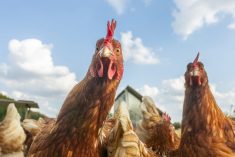If you plan on being reincarnated in the next life, hope to come back as one of the bucking horses owned by the Calgary Stampede. It ain’t bad. Room and board for the rest of your life, 23,000 acres of scenic Prairie grassland over which to ponder the meaning of the universe, and during the busy season you might have to work eight seconds a week.
That’s the story after a recent visit to the Calgary Stampede Ranch near Hanna, about two hours northeast of Calgary. The ranch, owned by the Calgary Stampede since 1961, is where they raise, evaluate and train most of the bucking horses used during the rodeo events at the Stampede.
Read Also

U.S. livestock: Cattle strength continues
Cattle futures on the Chicago Mercantile Exchange were stronger on Friday, hitting fresh highs to end the week.
And with between 500 and 600 head of horses on the sprawling ranch, located within the Special Areas of eastern Alberta, the facility also serves as an important stock contractor supplying horses for rodeos across North America.
Despite serious flooding at the Stampede grounds in Calgary in late June, Stampede officials say the show will go on “come hell or high water,” so you can catch some of these horses in action July 5 to 14.
I always thought producing a bucking horse involved finding an animal with the rankest temperament, throwing a saddle and rider on the beast, snugging up a prickly strap against its tender parts, letting it loose and spurring the heck out of it. And between rides I figured it was someone’s job to jab these critters with a stock prod just to keep them ornery. I also assumed once they ran out of steam for bucking, they were shipped to the proverbial “glue factory” with an eternally grateful thank-you note. But I was wrong on all counts.
If you’re an equine that happens to make the cut as a Calgary Stampede bucking horse, you pretty well have it made in the shade. It’s almost as good as being named a senator in the Canadian government. The only downside compared to being in the Upper Chamber is the horses do have to work at least eight seconds per week.
Raymond Goodman, ranch manager seems to be one of those genuine people who loves horses and loves his job. (Don’t get him talking about now-retired six-time world champion bucking horse Grated Coconut, you’ll be there all day.) Goodman oversees the operation of the ranch and the remuda of horses with an obvious commitment to do things properly, including ensuring the proper care, treatment and comfort of horses at all times.
Bucking horses are born to buck. That may seem obvious, but Goodman and ranch veterinarian Dr. Greg Evans say it isn’t clear whether bucking is a true genetic trait or just a personality characteristic of horses, but regardless it is a skill or behavior that is passed on from one generation to the next.
The bucking broncs at the Calgary Stampede Ranch are “trained” through a reward system to enjoy bucking. They always win.
Goodman and his ranch crew work with young horses that come with bucking bloodlines. Many are raised right on the ranch, bred up through the bloodlines of proven bucking mares and stallions.
At three to four years of age these unbroken horses are first exposed to a “bucking dummy.” It is a 40-pound, boxy-looking device, placed over the front shoulders and cinched on like a saddle. A key feature of the dummy is that it comes with a remote-control release switch. It is put in place, the horse doesn’t like the feel of this weight on its back, the horse bucks, and after a few seconds the trainer hits the switch, the cinch is released, the dummy falls off and the horse wins.
They work with this dummy for a while, hoping to reinforce the notion that bucking gets rid of the unfamiliar load. From the inanimate bucking dummy, the next step is to find some young novice riders to put on the horse’s back. The rider is a much different, yet unfamiliar feel, so the horse bucks and after a few seconds the rider is on the ground. Again the horse wins.
The final step is to move into full-sized, experienced cowboys… but again, even if they stay on for the maximum ride — eight seconds — bucking gets rid of the rider and the horse wins.
Through this process the horse learns that bucking gets rid of that unfamiliar and unwanted feeling on its back. As Bonni Clark of the Calgary Stampede points out, “in the horse’s mind, it always wins.”
These bucking horses, whether bareback or saddle broncs, ideally perform in a rodeo only once a week. Aside from travel time, and getting ready for the event, they are bucking no more than eight seconds and then it’s back to pasture.
The best of the retired bucking horses, such as Grated Coconut, are put into a breeding program, and the rest are turned out to the proverbial and literal pasture for the rest of their lives. It’s a pretty good gig for a bucking horse — a very short work week, and long-term security in old age. If all Stampede employees get the same benefit package, you’ll find me hanging out around the barns with a pitchfork just waiting for an opening.
— Lee Hart is a field editor for Grainews in Calgary. His “Lee’s Insight” blog is in between platforms but will appear, in the meantime, here in the Daily News feed on the AGCanada.com Network. Contact Lee at 403-592-1964 or by email.



















